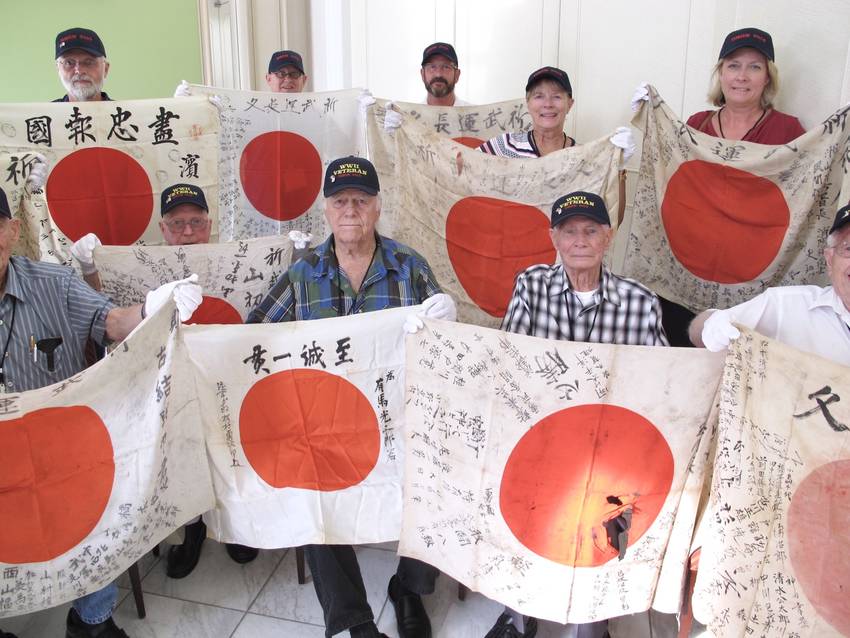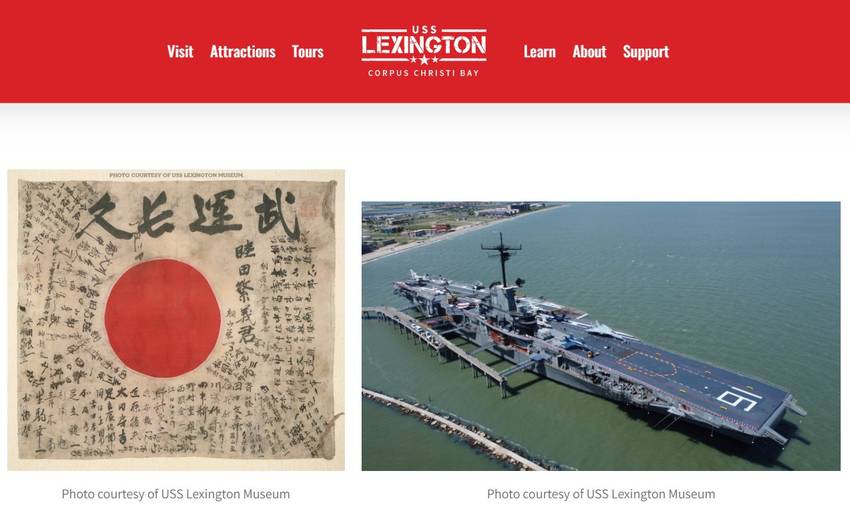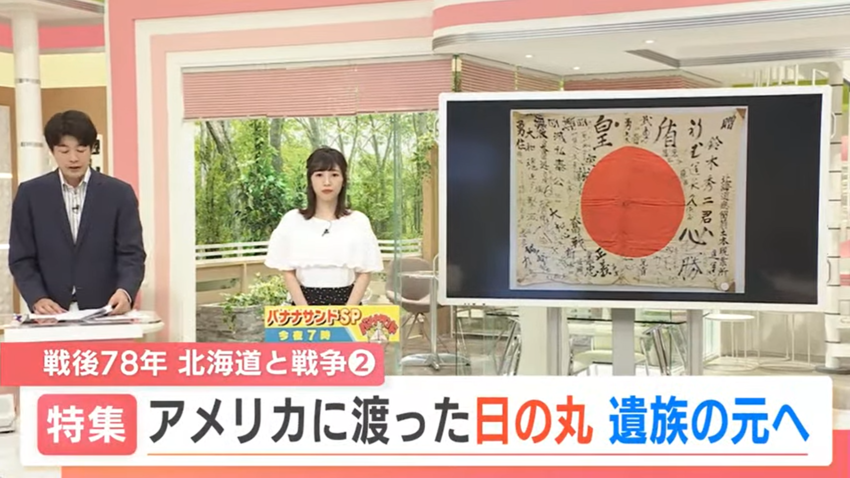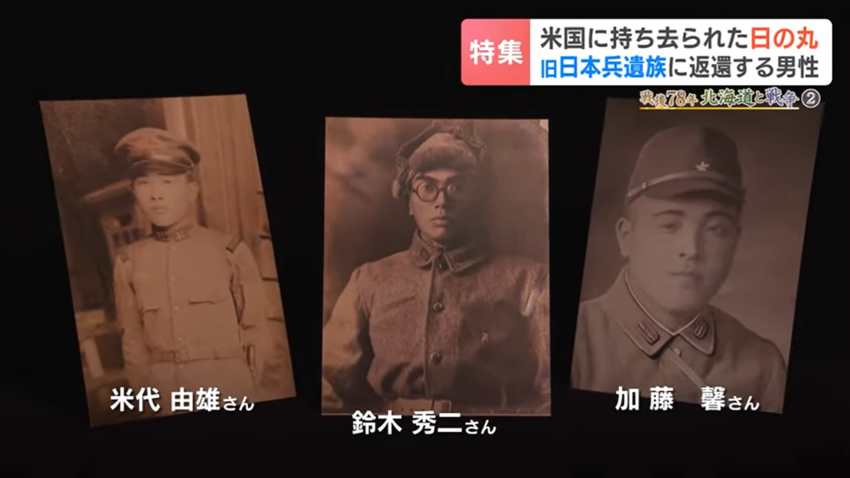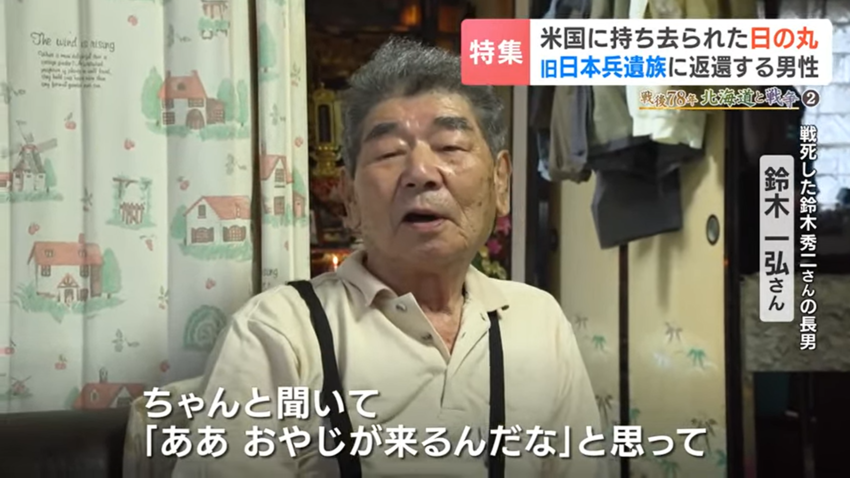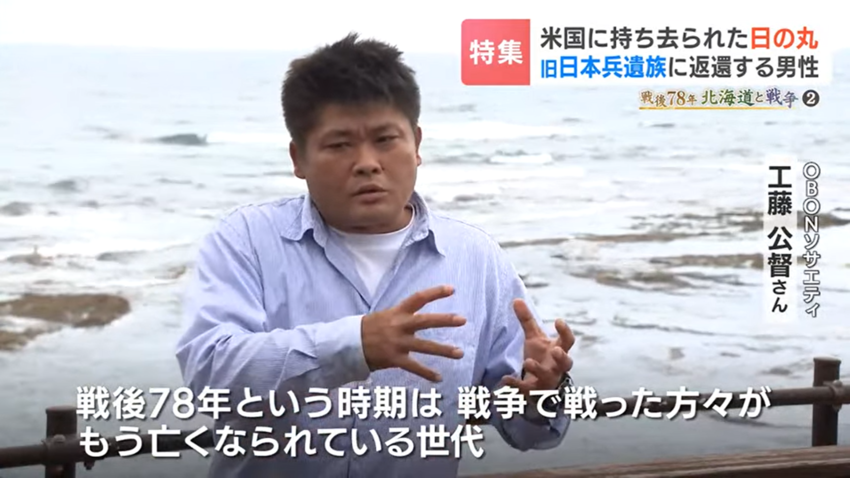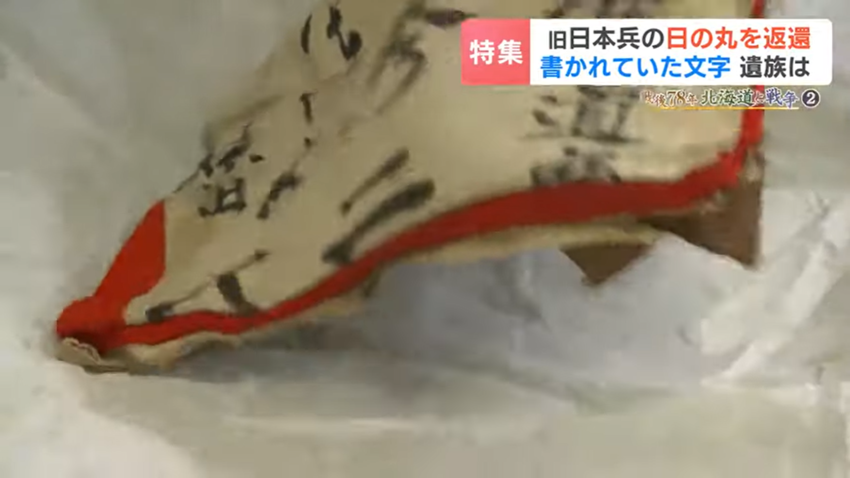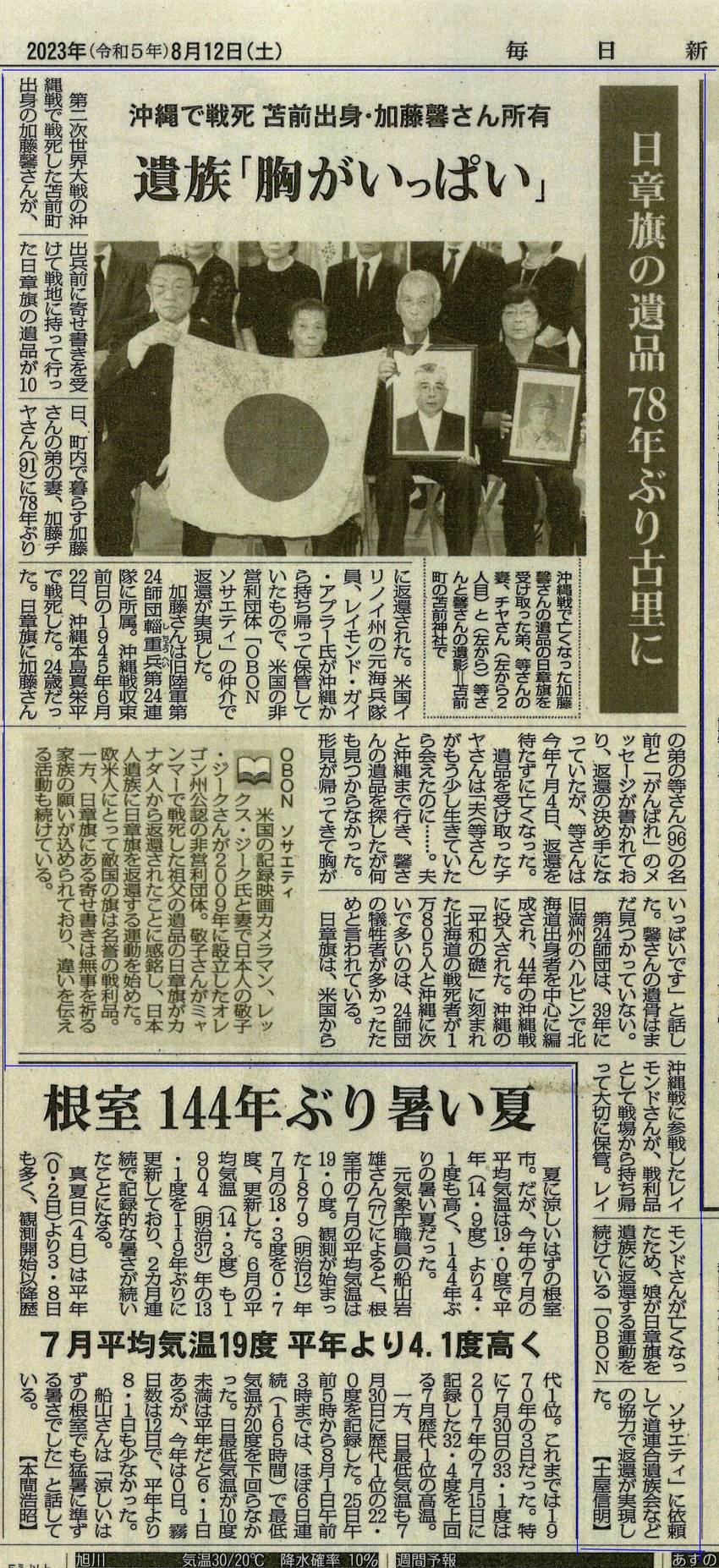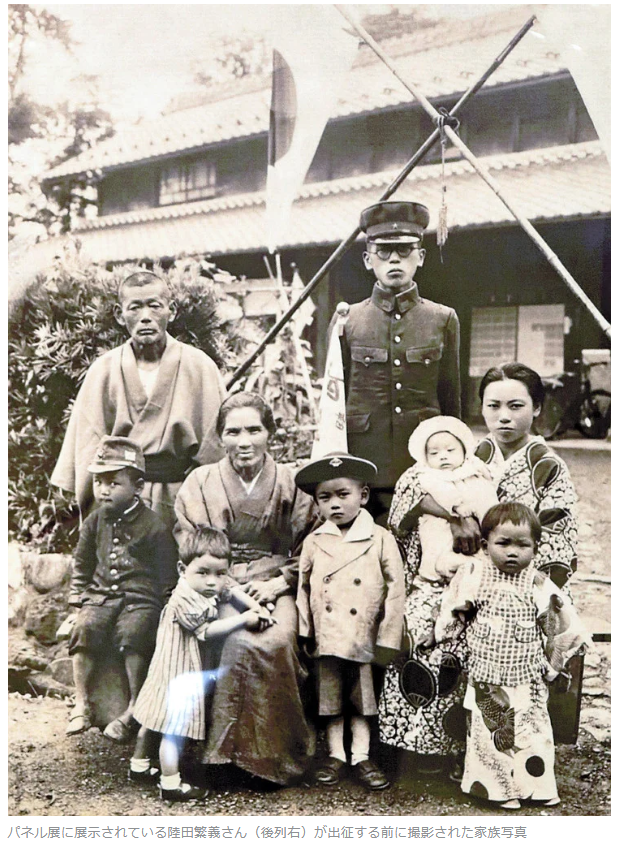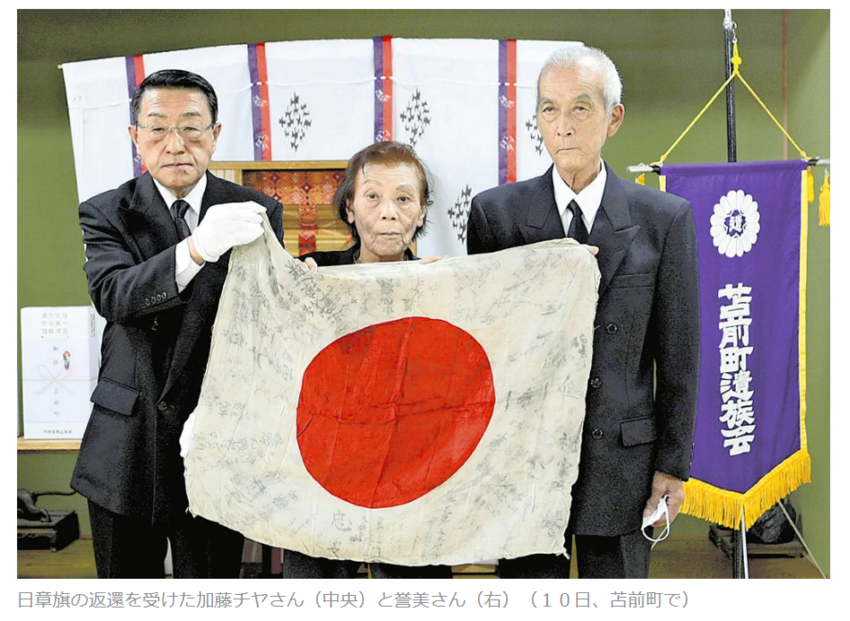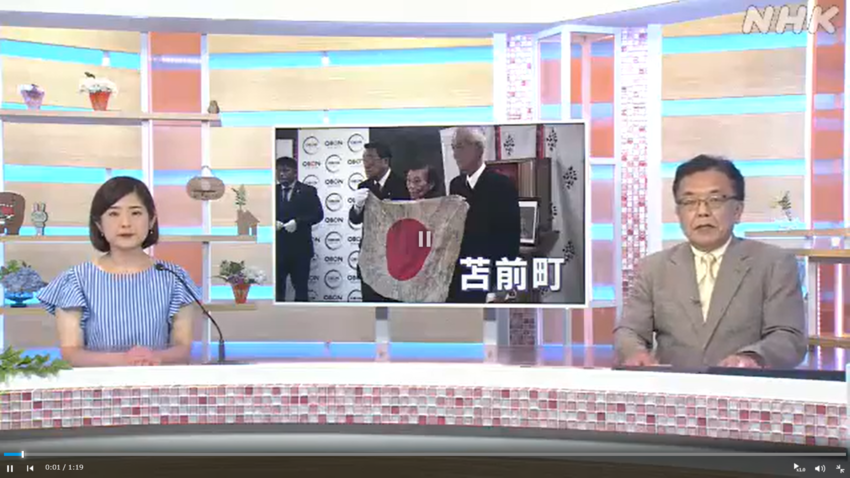- ハッシュタグ「#japanesflag」の検索結果175件
8月26日、滋賀県大津市にて執り行われました戦没者追悼式の後、東近江市出身の旧日本兵「門阪庄平」命の日章旗返還式がご遺族へ返還されました。
滋賀県の戦没者追悼式が26日、大津市にある県立体育館で開かれました。追悼式には、遺族ら関係者約620人が出席しました。
滋賀県の戦没者は、3万2715人。追悼式では、県遺族会の今堀治夫会長が「悲惨な悲しみの歴史を二度と繰り返さない、繰り返させない。戦争の愚かさと平和の尊さをかみしめて、次世代に語り継ぐ」と追悼の辞を述べました。このあと献花が行われ、出席した三日月知事や遺族らが、恒久平和を願っていました。
また追悼式の後、戦争遺留品の返還式が行われました。返還された日章旗は、1944年10月にフィリピンのレイテ島で、20代の若さで戦死した東近江市の門阪庄平さんのもので、三日月知事から弟の杢平さんに日章旗が手渡されました。
旗には「武運長久」の文字や庄平さんの友人の名前がびっしりと記され、陸軍へ入隊するために家を出発する際、庄平さんが肩にタスキがけにしていたものだということです。
https://news.yahoo.co.jp/articles/9c19061b179063456af697cfb07cb09577ba1289
![Sending the Yosegaki Hinomaru ...]() Sending the Yosegaki Hinomaru back home to where they belong.
Sending the Yosegaki Hinomaru back home to where they belong.
Please click the link below to read about OBON SOCIETY's invitation to speak at the Sasakawa Peace Foundation USA's event.
https://mailchi.mp/f64484830ee4/8q6sybk9gw

![News release from the USS Lexi...]()
--The Good Luck Flag Repatriation Ceremony will take place aboard the USS Lexington Museum on Thursday, July 20th, at 9:00am. This ceremony is open to the public.---
WHAT:
Japanese Good Luck Flag Repatriation Ceremony
WHERE:
USS Lexington Museum – Hangar Bay
WHEN:
Thursday, July 20, 2023
9:00AM
USS Lexington Museum is working in partnership with the OBON SOCIETY to repatriate the flag back to Japan for the flag to be reunited with the soldier’s surviving family members. OBON SOCIETY is a non-profit organization that over the past 13 years has repatriated more than 500 flags back to Japanese families and communities. The organization’s founders, Rex and Keiko Ziak, will act as representatives of the family to bring their long-lost patriarch home, including a ceremonial reuniting with his wife who recently passed at the age of 102. Representatives from OBON SOCIETY and the USS Lexington Museum will then accompany the flag on its journey back to Japan and the family.
https://usslexington.com/uss-lexington-museum-a-wwii-era-aircraft-carrier-will-return-japanese-flag-to-reunite-generations/?fbclid=IwAR3rxmlaH4u4PFzwm_VuUwnt8AD1HOGcoGGjj1wsOuLrl_L0v7o9R7k8Clo
きょうは、「終戦の日」です。戦後78年、激しい戦場となった沖縄戦で亡くなった男性の日章旗が先日、北海道の遺族に届けられました。その家族の思いを取材しました。(2023年8月15日放送) #日章旗 #戦後78年 #沖縄戦 #遺族 #戦死 #沖縄 #平和祈念公園 #遺品 #北海道 #STV
8月15日は終戦の日です。 戦後、アメリカに渡った旧日本兵の日の丸を遺族の元に返す取り組みを続ける男性に密着しました。
https://www.youtube.com/watch?v=v2-ia8FiC9k&t=4s

8月15日は終戦の日。 太平洋戦争が終わって78年を迎えます。 激しい地上戦となった沖縄では、多くの北海道出身の兵士も命を落としました。 その中のひとりの兵士が身につけていた「お守り」が道内にいる家族のもとへかえりました。
*** 「必勝」「突破」。 寄せ書きされた数々の激励の言葉。 一緒に働く仲間から、戦地に向かう兵士の幸運を祈って贈られた「日の丸の旗」です。 いつ、ついたのでしょう。 血の痕のようなものも…。
■鈴木久子さん: 「よくね、長い年月、耐えたと思いますね…」
■シュバートさん: 「どうしてもその旗を日本の家族へ返す必要があったんです」沖縄、アメリカ、そして北海道へ。 地獄と呼ばれた戦場で命を落とした兵士の「日の丸」がおよそ80年という歳月をかけて家族のもとへかえってきました。
▼沖縄戦太平洋戦争末期、一般住民をも巻き込んだ沖縄戦。 空襲や、海からの艦砲射撃に加え、陸では銃や火炎放射器など激しい攻撃により、沖縄は地形が変わるほどの被害を受けました。 おびただしい数の砲弾が撃ち込まれる様子は、「鉄の暴風」として語り継がれています。 3か月に及ぶ激しい戦闘でおよそ20万人が犠牲に。 沖縄県民に次いで死者の数が多いのが北海道出身者です。 その数、1万805人。 主に満州から沖縄に向かった部隊の兵士です。
■鈴木久子さん: 「これなら1本入ったら華やかだね」 …札幌市に住む鈴木久子さん、87歳。 9歳のときに、父親が沖縄で戦死しました。 6月はじめのある日、沖縄戦で戦没した北海道出身者の慰霊碑がある札幌護国神社を訪れ、花を手向けました。
■鈴木久子さん:「ここだね。母さん、父さんのとこだよ」 久子さんの父・米代由雄さんは、沖縄・糸満市で車両を運転中、戦闘機の機銃掃射を受けて即死。 35歳でした。 助手席に同乗していた仲間が終戦後、最期の状況を久子さんの母に伝えたといいます。
■鈴木久子さん:「きょう祥月命日ね。沖縄は、まだ梅雨のまっさかりです。」 「尺八を吹いていたのを覚えてますけどね/のど自慢の男の人たちが集まってきて、父の尺八で江差追分とか、ああゆうのを歌っている姿を。」 小さいころのときに、目にも耳にも残ってますけれど」由雄さんが沖縄で戦死してから78年。 札幌で暮らす長女・久子さんのもとへ、父が戦地に持って行った「日の丸の旗」が見つかったと、連絡が入りました。 当時、ほとんどの兵士たちが肌身離さず持っていたという日の丸の旗。 親しい人から直筆の寄せ書きがされていて日本兵にとっての「お守り」でした。 しかし、アメリカ兵にとって敵軍の旗は一番の「戦利品」とされ、 当時、たくさんの日の丸が戦場から持ち去られました。 由雄さんの日の丸をアメリカに持ち帰ったのは、当時、陸軍に所属していたジョン・コルベルさんでした。
■米国在郷軍人会ジェイムス・V・シュバート: 「彼は5枚の日本の旗を持っていました。1975年に彼が亡くなるまで旗はクローゼットの引き出しに保管されていました。」 その後、息子のジョンさんがこの旗を引き継ぎますが、2017年に亡くなり妻のキャロルさんが、在郷軍人会に旗を寄贈しました。
■シュバートさん「旗を手にしたとき、これはアメリカにとっての記念品ではないと思いました。 圧倒されるような感覚やスピリチャルな存在を感じ、私たちが持つべきものではない日本の家族が持つべきものだと思いました。」 そこで、こうした旗を日本の遺族へ返す活動をしているアメリカのNPOに、持ち主の家族を探すよう依頼。 由雄さんは七飯町の出身にも関わらず、旗には当時の勤務地だった「平取」とあったことから捜索は困難を極めました。 しかし、米代という珍しい苗字を手掛かりに、およそ2年半をかけて娘の鈴木久子さんにたどり着きました。 こうした旗が、長い月日を経て、いま少しずつ日本へ。 北海道でも現在14枚が家族のもとへかえっています。
■OBONソサエティ工藤公督さん: 「米国サイドで、日本兵がそのように(お守りと)して持っていた旗と知ったときにそんな意味があるものだったということに気づかないで長年持っていたということに対して、ものすごく引け目ではないですけれど。 そういうことであれば一刻も早く日本のご遺族に返還してあげたいと」
■鈴木久子さん: 「やっぱりドキドキするわね。 こんなに大仕掛けになるとは思わなかったものだからね」沖縄戦が終結した6月23日。 札幌護国神社でも、毎年、沖縄戦犠牲者の慰霊祭が開かれています。 今年は、父・由雄さんの旗を受け取る久子さんのため、慰霊祭の合間に返還式を執り行うことになりました。
■元北海道沖縄会会長黒田練介さん: 「日の丸の返還は、戦没霊の魂が家族に暗に帰ってきたことになり、大変意義深いことです。」
■鈴木久子さん: 「よく、長い年月耐えたと思いますね。きっと今残っているたった一人の娘に戻ったっていうことは喜んでくれているんでないかなとは思います。 」妻や幼い子どもを故郷に残し、戦地に赴いていった日本兵たち。 彼らがお守りとして身につけていた寄せ書きの日の丸は、未だアメリカに2500枚以上あり、家族のもとへかえる日を待っています。
■鈴木久子さん: 「薄っぺらい布地だけど。78年の年月の重みですこの旗は
https://www.youtube.com/watch?v=xMzJC9Rs6ps&t=14s
日章旗遺族に 沖縄で戦死 苫前出身の加藤さん
太平洋戦争末期に沖縄で戦死した苫前町出身の加藤馨さんの日章旗が米国から返還され、10日、遺族に手渡された。
加藤さんは1921年生まれ。後方支援を担う旧陸軍第24師団 輜重しちょう 兵第24連隊第五中隊伍長で、1945年6月22日、沖縄本島・ 真栄平まえひら で戦死したという。
日章旗は、沖縄戦に従軍した米海兵隊員が持ち帰り、長らく保管されていた。隊員が2016年に死去した後、日章旗を引き継いだ娘が米国の非営利団体「OBONソサエティ」に所有者と遺族の捜索を依頼。日本遺族会などを通じて加藤さんの弟、等さんを捜し当てた。日章旗には「がんばれ 加藤等」と記されていた。
返還の一報は今年3月、等さんに伝えられたが、7月4日に死去し、この日の返還式への出席はかなわなかった。
親族らが出席した式では、等さんの妻チヤさん(91)と長男の 誉美たかみ さん(71)が福士敦朗町長から日章旗を受け取った。遺族を代表し、誉美さんは「式を目前に父は亡くなってしまったが、どこかで見守ってくれていると思う」とあいさつした。
等さんは戦後、兄の馨さんを捜しに沖縄を訪ねたことがあり、平和祈念公園の平和の 礎いしじ に刻まれた加藤さんの名前を何度もさすっていたという。チヤさんは「(日章旗を)仏壇にお供えしたい」と話した。
https://www.yomiuri.co.jp/local/hokkaido/news/20230810-OYTNT50172/
太平洋戦争の沖縄戦で24歳の若さで亡くなった苫前町出身の男性が持っていた日章旗が、終戦から78年となるのを前に遺族に返還されました。
返還された日章旗は昭和20年6月に沖縄戦に出征し、24歳で亡くなった苫前町出身の加藤馨さんが持っていました。
10日、苫前町内の神社で行われた返還式には、馨さんの弟の妻、加藤チヤさんなど遺族が出席し、福士敦朗町長から日章旗を受け取りました。
チヤさんは涙を浮かべ、日章旗に「おかえりなさい」と語りかけていました。
日章旗は沖縄戦に参戦した元アメリカ兵が持ち帰っていましたが、その娘が戦没者の遺留品を遺族の元に返す活動をしているアメリカのNPO「OBONソサエティ」に遺族を捜し出して返還するよう依頼したということです。
加藤馨さんのおいの加藤誉美さんは「弟にあたる私の父は日章旗の返還を前に7月に亡くなりましたが、きょうは天国から見守ってくれていると思います。日本が二度と戦争がない平和な国であるように願っています」と話していました。
https://www3.nhk.or.jp/sapporo-news/20230810/7000059913.html?fbclid=IwAR3k6Kv_nZ0PjOWeFhdQ-iqXeq_CCVvh8-hpabZ30OuIqw2cH0Zi_mZu4hk
- ブログルメンバーの方は下記のページからログインをお願いいたします。
ログイン
- まだブログルのメンバーでない方は下記のページから登録をお願いいたします。
新規ユーザー登録へ





